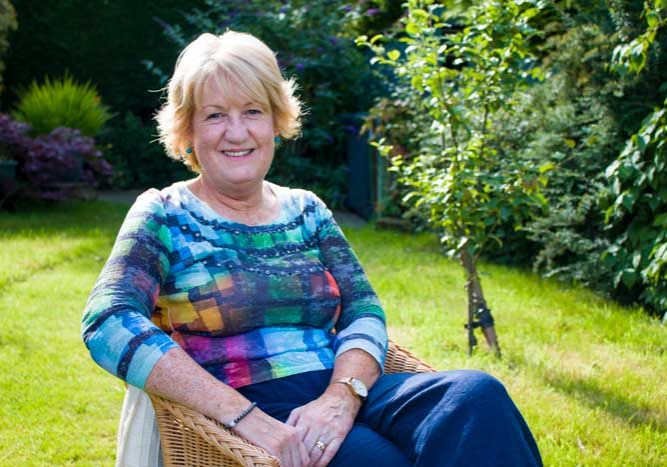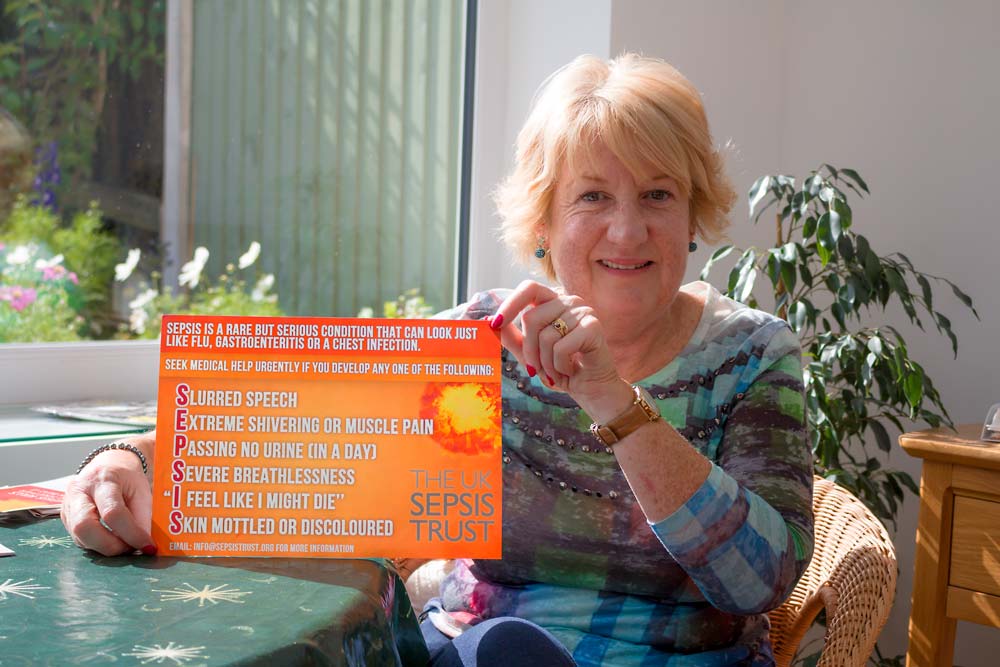
Sepsis survivor Julie Carman, highlights the key signs of sepsis
by Eric Beardsworth
It kills about 40,000 people a year in Britain, but in terms of public awareness it’s not up there with cancer and heart disease.
It’s called sepsis – also septicaemia or less accurately ‘blood poisoning’ – and sepsis survivor Julie Carman is campaigning hard to make people more aware of how this potential killer can strike with terrible swiftness and how it can be stopped if treated quickly.
Julie, 61, of Quernmore Drive, Kelbrook, is the voluntary organiser of one of three regional support groups of the UK Sepsis Trust, which helps people recovering from sepsis and those who have lost loved ones to the condition.
Sepsis nearly killed Julie, who worked for the NHS, after she was injured in a cycling accident in 2008. A couple of months after being discharged from hospital she was recovering at home when she began to feel unwell. She thought she had flu and dosed herself with paracetamol over the weekend thinking she was a bit run down.
Julie takes up the story: “By Monday I felt much worse so my husband ran me down to the surgery and they diagnosed cellulitis and referred me to my local hospital. I was asked to go to A and E. Once there I was triaged and it was felt I had an infection but they were unclear whether the infection was in my leg or in my jaw. I had a number of injuries, fractures, and haematomas on my face, jaw, hips and legs, so I was passed between various departments and then sent to another hospital to get checked out by their Max/fax (maxillofacial) department.
“Although the need for antibiotics was mentioned on many occasions, none were given and I continued to deteriorate with a high temperature, rigours and vomiting. Eighteen hours after first presenting at my GP’s I was admitted to an emergency bed.
“Although I felt dreadful I enquired about the antibiotics as I had not been given any. They had not been written up so there was a further delay but eventually drips were put up and treatment started. After 10 days I was discharged on full bed rest and with my legs bandaged from ankle to thigh.
“A couple of days later the rigours started again so my husband took me back to the ward I had been discharged from a couple of days earlier but they said I needed to go to A and E. After a delay of approx five hours I was seen, my legs were unwrapped and foul-smelling discharge poured from various crevices in my left leg.
“I was seen by an orthopaedic surgeon and IV antibiotics were started and I was told I would need an urgent operation to remove necrotic muscle and hopefully save my left leg. The necrotic muscle was removed and after another 10 days in hospital I was discharged. It took me a long time to fully recover.
“The work on replacing my fractured teeth had to be delayed due to sepsis episodes, to allow my body to recover, and this led to a breakdown. I was ashamed I’d had an accident, ashamed I’d not spoken up, ashamed of the NHS.”
Instead of blaming failures in the hospital system for her ordeal, Julie decided to dedicate herself to raising awareness of sepsis in adults and children, to help prevent it happening to others. She has also fought her way back to fitness, taking hydrotherapy and building up to the Great North Swim at Windermere, where last year she covered a mile in under an hour. She has also taken part in Pendle Park Run.
Julie said: “I realise how lucky I am to be here, how quickly sepsis can take hold and how important it is that it is spotted and diagnosed and treated quickly.”
Julie featured in a film made for the Sepsis Trust which is shared by doctors and health professionals, and she has met MPs to lobby for support.
A major breakthrough for sepsis campaigners came in July when NICE, the National Institute for Health and Care Excellence – published new guidelines to recognise sepsis and deal with it.
Sepsis occurs when the body’s response to an infection goes wrong and becomes overwhelmed, injuring its own tissues and organs.

Key signs of sepsis
S: Slurred speech
E: Extreme shivering or muscle pain
P: Passing no urine in a day (kidney trouble)
S: Severe breathlessness
I: “I feel like I might die.”
S: Skin mottled or discoloured.
The condition affects 10,000 children a year, and can be recognised by: fast breathing; fits or convulsions; mottled, bluish or pale skin; a rash that doesn’t fade when pressed; lethargic or difficult to wake, feels cold to touch. In under-fives, it can be recognised by the child not feeding, vomiting repeatedly, and not having a wee or wet nappy for 12 hours.
Julie added: “Our slogan is ‘Think Sepsis’. We want doctors to treat it with the urgency they’d give a heart attack, and get the patient to hospital as quickly as possible.”
For more information, visit www.sepsistrust.org




